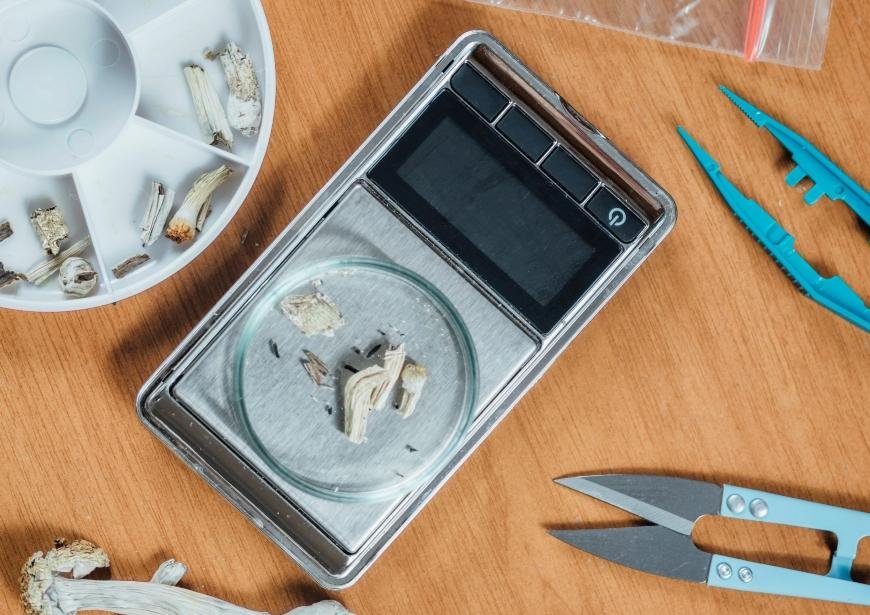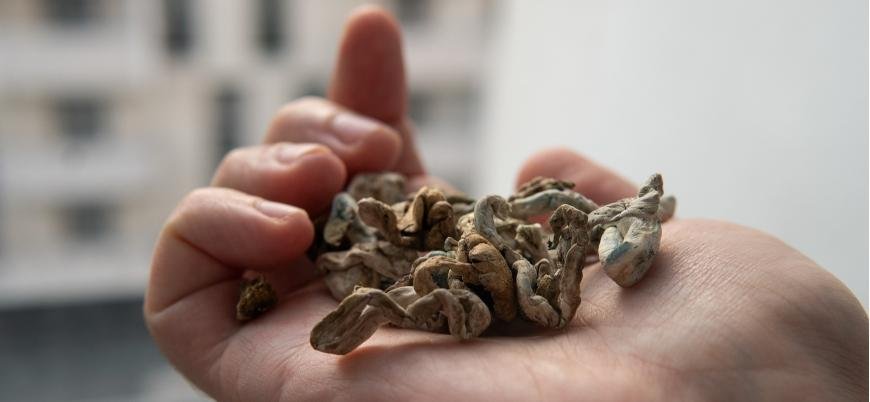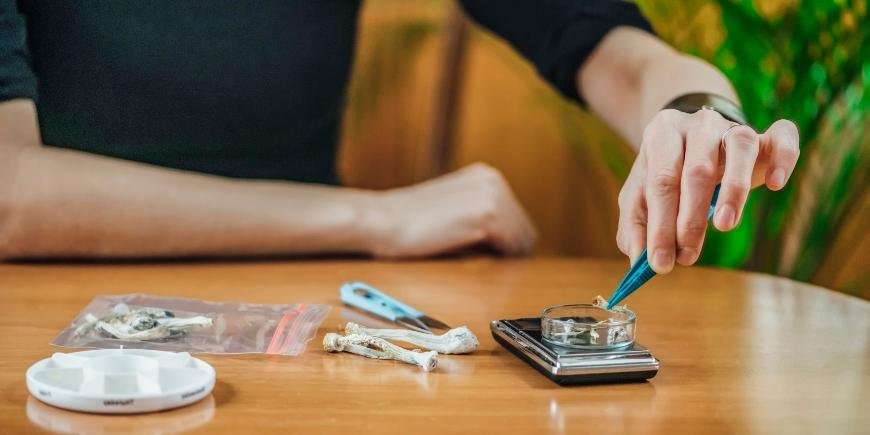Microdosing Mushrooms
Discover the potential benefits of microdosing mushrooms and learn how to do it safely and responsibly. Get all the information you need to unlock the power of microdosing mushrooms.

Microdosing mushrooms has become a popular way to experience the benefits of psychedelics without the full-on effects. For those looking for an enhanced sense of wellbeing, creativity, and mental clarity - microdosing with mushrooms can be just what you need. In this article, we will explore the potential benefits, safe and responsible methods of microdosing mushrooms, various mushroom species used for it as well as associated risks - so if you're curious about this trend then read on. So if you're interested in learning more about this emerging trend - read on.
Table of Contents:
- What is Microdosing Mushrooms?
- Benefits of Microdosing Mushrooms
- How to Microdose Mushrooms
- Types of Mushrooms for Microdosing
- Risks and Precautions with Microdosing Mushrooms
- Conclusion
What is Microdosing Mushrooms?
Microdosing 'shrooms involves taking a very small amount, usually between 0.2 and 0.5 grams, of psychedelic fungi to obtain subtle changes in one's mental state without having an intense trip experience. With its potential to promote creativity, focus and well-being without intense hallucinations, microdosing mushrooms has been gaining traction as an alternative approach. Microdosing involves consuming a low enough dose so that you won’t feel any physical or psychological effects from it other than a mild feeling of relaxation or clarity.
The benefits of microdosing mushrooms vary depending on the person and what they’re hoping to gain from it. Generally speaking, microdoses have been reported to increase creativity and productivity while reducing stress levels and anxiety symptoms in some individuals. Some users also report enhanced feelings of connection with nature or spirituality when using psychedelics at this lower dosage level. Additionally, studies have shown that regular use may lead to improved cognitive functioning over time as well as increased emotional stability throughout the day after dosing sessions end.
Prior to initiating a microdosing regimen, it is critical to have reasonable anticipations and ensure security by abstaining from driving or operating heavy machinery while under the influence. One should be aware of potential risks such as paranoia or panic attacks that may arise when using psychedelics, and take necessary precautions to ensure safety. Furthermore, drug interactions should be taken into consideration if combining substances; thus, finding an appropriate source for obtaining quality product free from contaminants is essential. To start out slowly until comfortable with dosages taken, timing dosages correctly based on personal body chemistry (e.g., morning vs evening) is recommended before ramping up usage and consulting medical professionals if pregnant/nursing/taking medications already is advised.
Choosing the right mushroom for microdosing depends on personal needs and goals. Popular options include Psilocybe cubensis, Amanita muscaria (Fly Agaric), Gymnopilus junonius (Spectacular Rustgill), Copelandia cyanescens (Blue Meanies) and Inocybe aeruginascens (Cobweb Mottlegill). Each of these fungi possess distinct characteristics that can be tailored to one's particular needs. For those looking for a more subtle effect without any psychoactive compounds, Lion's Mane is an excellent choice due to its high content in beta glucans and polysaccharides known as "smart drugs".
It is rare compared to other natural remedies, but there can be risks involved when experimenting with psychedelics such as nausea or vomiting resulting from improper dosage amounts consumed too quickly. Caution should always be exercised when considering usage even at lower levels than normal recreational doses would involve, especially for those who have pre-existing conditions like heart problems or high blood pressure. It is wise to do thorough research prior to engaging in any sort of shroomin' adventures.
Microdosing mushrooms is an increasingly popular practice that involves taking small doses of psychedelic substances to improve mental and physical health. The next heading will explore the potential benefits of microdosing mushrooms, such as improved mood, increased focus, and reduced anxiety.

Benefits of Microdosing Mushrooms
Microdosing involves ingesting small doses of psychedelics such as psilocybin mushrooms, LSD or other serotonergic compounds for therapeutic purposes rather than recreational ones. Psychedelic substances like psilocybin, found in magic mushrooms, can cause drastic shifts in awareness when consumed at larger amounts.
At lower doses, however, microdosing can be used to enhance creativity and productivity while also providing potential mental health benefits such as improved mood and decreased anxiety. Investigating the possibility of taking a small quantity of certain substances on a regular basis (typically three days apart) could offer advantages such as enhanced creativity and productivity, in addition to possible mental health improvements like improved mood and reduced anxiety - all without any adverse reactions including fear or confusion.
Though the precise means of action for microdosing remain unclear, hypotheses abound concerning its potential to confer mental and physical benefits. One theory suggests that because we only take very small amounts of the drug each time, it doesn’t reach levels high enough to trigger an intense psychedelic experience but instead produces subtle changes over time that add up into something more significant. Another theory proposes that by introducing small amounts of serotonin into our system through regular dosing sessions we could potentially create long lasting positive neurological changes within ourselves leading us towards greater emotional stability and wellbeing overall.
Microdosing mushrooms can offer a variety of benefits, including improved mood and focus. With the right information on how to microdose safely and effectively, these positive effects can be further enhanced. Moving forward, let's explore the different ways you can microdose mushrooms for maximum benefit.
How to Microdose Mushrooms
Microdosing mushrooms is a process of consuming small doses of psychedelic substances, such as psilocybin-containing mushrooms, to experience the benefits without full-blown hallucinations. Microdosing can be used for therapeutic purposes or simply to enhance creativity and productivity in everyday life.
Start with a small dose and increase incrementally until you find the optimal amount for your needs. Generally speaking, most people take between 0.2g - 1g of dried mushroom material per day spread out into 2 - 4 smaller doses taken throughout the day. For example, some people prefer taking two 0.3g doses each morning and evening while others prefer one 0.5g dose once a day at noon or midnight depending on their lifestyle needs and preferences.
Carefully select your mushroom for microdosing, as various types can contain different levels of strength. Popular choices include Psilocybe cubensis (a.k.a the typical “magic mushrooms”), Panaeolus cyanescens (also known as “blue meanies”) and Copelandia cyanescens (or “Hawaiian shrooms”). As with anything new, start small in order to avoid any potential unpleasant surprises – you can always increase the dose if needed.
Microdosing mushrooms can be a great way to explore the effects of psychedelics in small doses. By understanding the types of mushrooms that are best for microdosing, you can find one that works well with your body and lifestyle.
Types of Mushrooms for Microdosing
Microdosing mushrooms is becoming increasingly popular, especially among young adults. The practice involves taking small doses of psilocybin-containing mushrooms to experience subtle changes in mood and perception without the intense psychedelic effects of a full dose. Small amounts of various fungi can be consumed for microdosing, each providing distinct properties and advantages.
The most common type of mushroom used for microdosing is Psilocybe cubensis, also known as “magic” or “golden teacher” mushrooms. These fungi, are amongst the most readily accessible psychedelics out there; thus making them an optimal option for those just beginning with microdosing. They produce mild visual hallucinations and feelings of euphoria that can help improve focus and creativity while reducing stress levels.
Another type often used for microdosing is Psilocybe semilanceata, commonly referred to as “liberty caps” or “shrooms” due to their distinctive bell-shaped caps. These are generally more potent than other varieties but still provide a milder trip than a full dose would offer. Liberty caps have been reported to increase energy levels while providing improved clarity and insight into personal issues.
Psilocybe azurescens is another variety that has become increasingly popular among experienced users looking for stronger effects from their doses than what they get from cubensis or liberty caps alone. This species produces much higher concentrations of psilocybin compared to other types which makes it more likely to produce intense visuals at even low doses when combined with other substances like cannabis seeds or truffles. However, these strong effects come with increased risks so it's important to start slow if you decide this type is right for you.
The types of mushrooms available for microdosing vary greatly and should be carefully researched to determine the best option for individual needs. Nevertheless, caution must be exercised when partaking in any type of mushroom ingestion due to the potential risks associated.

Risks and Precautions with Microdosing Mushrooms
Consuming minuscule amounts of psilocybin, the psychoactive compound in specific fungi varieties, can be used to attain various therapeutic advantages without going through a full psychedelic experience. While microdosing can be beneficial for some people, it’s important to understand and take precautions when considering this type of treatment.
The first risk associated with microdosing mushrooms is legal repercussions. In many places, the holding or utilization of mushrooms containing psilocybin is forbidden and could result in legal consequences. Consequently, individuals considering microdosing mushrooms should familiarize themselves with the legal status of psilocybin-containing fungi in their area.
Caution should be taken when engaging in microdosing mushrooms due to the absence of long-term studies on its safety and effectiveness. Given the potential risks of nausea, vomiting, dizziness, confusion or anxiety that may arise from too large a dose or if combined with other substances like alcohol or drugs, individuals should take caution when engaging in microdosing mushrooms as an alternative treatment. Therefore, it's best to seek out an experienced practitioner who knows how to guide people through the process safely and manage any potential adverse reactions that may occur during psychedelic sessions.
Micordosing Magic Mushrooms - Is It For You?
Care must be taken when microdosing with any substance to ensure that the risks are minimized. With proper research into the types of mushrooms available for microdosing and understanding how to do so safely, you may find yourself enjoying all the potential benefits that come along with this unique practice.





















































































































